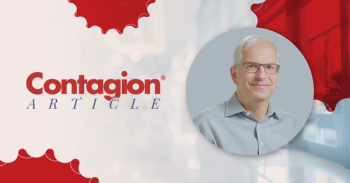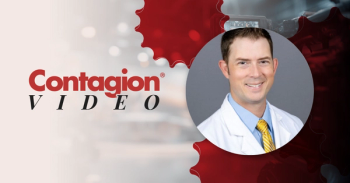
Addressing Resistance to Pathogens Such as NDM-CRE Through the Lens of Antimicrobial Development
Infections caused by NDM-producing carbapenem-resistant Enterobacterales have risen more than 4-fold since 2019, raising alarms about limited treatment options, delayed detection, and heightened risks of transmission and mortality in health care settings. TAXIS Pharmaceuticals Chief Scientific Officer Ajit Parhi, PhD, offers some insights on NDM-CRE, antimicrobial resistance, and an overview of his company’s pipeline.
US infections caused by New Delhi metallo-β-lactamase (NDM)–producing carbapenem-resistant Enterobacterales (NDM-CRE) spp increased by more than 460% from 2019 to 2023, according to a Centers for Disease Control and Prevention (CDC) analysis published in Annals of Internal Medicine. The CDC cautions that this surge could raise overall CRE infections and deaths beyond prior national estimates.
NDM-CRE spp cause pneumonia as well as bloodstream, urinary tract, and wound infections and are resistant to many available antibiotics, leaving limited treatment options. Detection is frequently delayed because many clinical laboratories do not routinely perform carbapenemase testing, complicating targeted therapy and control measures.
TAXIS Pharmaceuticals Chief Scientific Officer Ajit Parhi, PhD, spoke with Contagion about NDM-CRE, antimicrobial resistance, and an overview of his company’s pipeline.
Contagion: Infections from NDM-CRE have seen a sharp increase. Can you provide some insights on why this particular group of pathogens is a public health concern?
Parhi: NDM-CRE has emerged as one of the most concerning threats in the antimicrobial resistance [AMR] landscape today. These organisms produce powerful enzymes—metallo-β-lactamases like NDM—that render carbapenems, often considered the antibiotics of last resort, completely ineffective. That alone makes them uniquely difficult to treat, often leaving physicians with few or no viable therapeutic options.
Unlike older, more common carbapenemases such as KPC [Klebsiella pneumoniae carbapenemase], NDM-producing strains are resistant to a broader range of antibiotics, including some newer agents developed to counter resistance. This limits treatment options and increases reliance on last-line or toxic therapies, which may be less effective or poorly tolerated. Compounding this is the fact that NDM-CRE infections—including bloodstream infections, pneumonia, urinary tract infections, and wound infections—are frequently associated with high mortality rates, particularly in immunocompromised patients or those in intensive care units.
From a public health perspective, the concern extends beyond individual treatment challenges. NDM-CRE is highly transmissible, with resistance genes carried on mobile genetic elements—such as plasmids—that can easily jump between bacterial species in the gut microbiome. These organisms often colonize patients asymptomatically, turning hospitals and long-term care facilities into silent reservoirs for transmission. Infections can occur when bacteria breach the gut barrier—particularly through medical devices like catheters, feeding tubes, or ventilators—and can spread rapidly in health care settings.
Recent CDC data underscore the urgency. While KPC-producing CRE had historically dominated in the US, NDM-CRE is now rising at an alarming rate. Between 2019 and 2023, NDM-CRE incidence rose significantly with particularly sharp increases in E coli [Escherichia coli], Klebsiella spp, and Enterobacter spp. In New York City alone, reported NDM-CRE cases jumped from 58 in 2019 to 388 in 2024, overtaking KPC-producing strains.
Factors driving this surge include overuse of broad-spectrum antibiotics, prolonged hospitalizations, pandemic-era strain on infection control practices, and delays in rapid diagnostics that allow NDM-CRE to spread undetected. Moreover, international travel and health care–associated exposures have contributed to global dissemination, making containment a cross-border challenge.
The rise of NDM-CRE is not just a clinical hurdle; it is a systemic threat that puts pressure on every part of the health care ecosystem. Without effective new therapies and enhanced surveillance, diagnostics, and infection control, these pathogens risk becoming the next major public health crisis, echoing the global disruptions we saw with COVID-19.
Contagion: Separately, why is antibiotic resistance increasing?
Parhi: One major driver of increasing antibiotic resistance is the lack of truly novel antimicrobials entering the market. The current pipeline remains sparse, and for decades, most approved agents have been incremental modifications of existing drug classes—what might be called Generation X innovations. These often provide only temporary clinical utility, as preexisting resistance mechanisms may already compromise their effectiveness.
Bacteria rapidly evolve in response to antimicrobial pressure. Due to both the duration and volume of antibiotic exposure—through overuse and inappropriate prescribing—resistance eventually develops to even our most commonly used drugs. The only sustainable path forward is the development of new agents with novel mechanisms of action. Transformational innovations, rather than iterative ones, are needed: molecules that target bacterial systems in ways for which no current resistance exists.
Watch this recent Contagion interview with Parhi.
Contagion: Can you provide an overview of what TAXIS is doing in terms of antibiotic development, including what is in its pipeline?
Parhi: TAXIS Pharmaceuticals is developing first-in-class therapeutics to combat antimicrobial resistance by addressing its root biological causes. Rather than taking incremental steps, TAXIS targets the core mechanisms that bacteria use to survive, replicate, and resist treatment, aiming to dismantle the infrastructure that enables antimicrobial evasion.
Our pipeline addresses 7 of the 10 most critical pathogens on the World Health Organization [WHO]’s bacterial priority pathogens list. All three of our lead programs have been designated as qualified infectious disease products [QIDPs] by the FDA [US Food and Drug Administration] and represent novel, first-in-class approaches to restoring antibiotic effectiveness.
- TXA709: FtsZ [filamenting temperature-sensitive mutant Z] inhibitor/oral anti-MRSA [methicillin-resistant Staphylococcus aureus] agent: TXA709 targets the bacterial protein FtsZ, which is essential for cell division. By blocking septum formation, TXA709 induces bacterial cell death through a completely novel mechanism of action.
- One of only 2 investigational antibiotics (out of 40 reviewed by the WHO) to fully meet criteria for a novel mechanism
- Completed phase 1 trial with no serious adverse events at doses up to 1.6 g per day
- Advancing into phase 1b and phase 2 trials for skin and skin structure infections, with promising results in combination with cefdinir
- TXA14007: efflux pump inhibitor [EPI]/IV [intravenous] combination therapy for gram-negative infections: Our EPI platform targets bacterial efflux pumps—one of the most significant resistance mechanisms in gram-negative bacteria—by blocking the expulsion of antibiotics from the bacterial cell, thereby restoring drug potency.
- Lead candidate TXA14007 [QIDP designated] is being developed with levofloxacin as a novel IV treatment for Pseudomonas aeruginosa in hospital-acquired and ventilator-associated pneumonia
- Backed by CARB-X [Combating Antibiotic-Resistant Bacteria Biopharmaceutical Accelerator] and currently supported by a 3-year, multimillion-dollar NIAID [National Institute of Allergy and Infectious Diseases] award
- Additional combinations in development using azithromycin to address E coli, A baumannii [Acinetobacter baumannii], and K pneumoniae
- Demonstrated efficacy in resistance suppression, animal models, and global clinical isolates
- TXA15054: DHFR [dihydrofolate reductase] inhibitor/oral therapeutic for STIs [sexually transmitted infections]: TXA15054 is a novel dihydrofolate reductase inhibitor, designed to selectively block bacterial DHFR, a key enzyme for DNA and RNA synthesis.
- First-in-class oral candidate for multidrug-resistant Neisseria gonorrhoeae and Chlamydia trachomatis
- QIDP designated and supported by a NIAID grant
- Demonstrated nanomolar potency against isolates resistant to both ceftriaxone and azithromycin
- Cleared 100% of infections in animal models within 3 days, outperforming current standard of care
Emerging programs: TAXIS is also advancing earlier-stage programs targeting Clostridioides difficile, vancomycin-resistant enterococci, nontuberculous mycobacteria, and fungal pathogens. These collaborations with global partners expand our reach into areas of urgent unmet medical need.
Through its pipeline, TAXIS is redefining the fight against AMR by pursuing not only new molecules but truly transformative mechanisms designed to overcome existing resistance and extend the utility of antibiotics for decades to come.
Contagion: There is a significant urgent need for innovation, investment, and policy support to address the global postantibiotic era. Can you talk about why this is so important and some of the prospective measures on the table?
Parhi: Antimicrobial resistance is not a distant threat—it is one of the most urgent and defining public health challenges of our time. The CDC recently reported a dramatic surge in infections caused by NDM-CRE.
Without effective antibiotics, the risk of a return to prepenicillin conditions becomes real, where minor infections can once again become life-threatening. Modern medicine depends on the availability of reliable antimicrobials: from surgical procedures to chemotherapy, transplantation, and intensive care. This reality demands bold, coordinated action among public and private stakeholders to foster true innovation in antimicrobial R & D [research and development].
Key strategies to address AMR include:
- Strengthening global surveillance systems
- Promoting antimicrobial stewardship and responsible use
- Increasing R & D investment in novel antimicrobial agents
- Expanding international collaboration and supportive policy frameworks
Consider this: The last major breakthrough in the antibiotic space—Augmentin, a combination of amoxicillin and the first β-lactamase inhibitor, clavulanic acid—was launched more than 4 decades ago, in 1981. β-lactamase is a core resistance mechanism affecting 5 major classes of penicillin-family drugs.
While pharmaceutical companies once invested actively in this space, most exited decades ago due to an unsustainable economic model: limited pricing potential for short-course curative therapies, high development costs, and market saturation by generics. Worse, preexisting resistance to me-too drugs further limited their utility.
As a result, few new antibiotics have been developed, and bacterial resistance continues to outpace innovation. While initiatives like CARB-X and NIH [National Institutes of Health] funding have supported early-stage discovery and preclinical development, they are insufficient to fill the late-stage pipeline. Private sector investment typically only materializes after phase 1 or even phase 2 trial completion, highlighting the critical role of policy support.
Although governments have long discussed solutions to AMR, concrete action has been slow. However, the COVID-19 pandemic underscored the global risks of unchecked infectious disease, bringing renewed focus to AMR's economic and societal costs. That’s why there is growing momentum for legislative measures like the proposed PASTEUR [Pioneering Antimicrobial Subscriptions to End Upsurging Resistance] Act, which would incentivize development through market-based pull mechanisms and reengage pharmaceutical companies in this critical space.
Tackling AMR requires more than new antibiotics; it demands a shift in strategy, with investment in pioneering technologies that introduce entirely new mechanisms of action. TAXIS is proud to be part of this shift, with a portfolio of novel investigational agents that address the root causes of resistance and aim to restore the power of antibiotics to save lives.
Newsletter
Stay ahead of emerging infectious disease threats with expert insights and breaking research. Subscribe now to get updates delivered straight to your inbox.


























































































































































































































































































